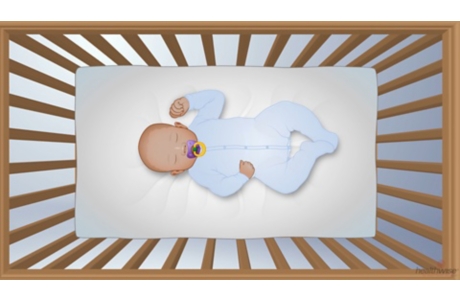Baby's Sleep Position and Sudden Infant Death Syndrome
Make an Appointment
Our team is here to help you make an appointment with the specialists that you need.
Baby's Sleep Position and Sudden Infant Death Syndrome
Overview
How can you reduce the risk of sudden infant death syndrome (SIDS)?
Doing certain things may help protect a baby from SIDS and/or other deaths related to sleep:
- Until your baby's first birthday, put your baby to sleep on their back, not on the side or tummy.
- Don't use tobacco, alcohol, or drugs while you are pregnant. And don't expose your baby to secondhand smoke during or after your pregnancy.
- For at least the first 6 months—and for the first year, if you can—have your baby sleep in a crib, cradle, or bassinet in the same room where you sleep. The American Academy of Pediatrics recommends that you don't ever sleep with your baby in the same bed.footnote 1
- Never sleep with a baby on a couch or armchair. And it is not safe to place your baby on a couch to sleep. It is not safe to place your baby in a car seat, sling, swing, bouncer, or stroller to sleep. The safest place for a baby is in a crib, cradle, or bassinet that meets safety standards.
- Keep soft items and loose bedding out of the crib. Items such as blankets, stuffed animals, toys, and pillows could suffocate or trap your baby. Dress your baby in sleepers instead of using blankets.
- Make sure that your baby's crib has a firm mattress (with a fitted sheet). Don't use sleep positioners, head-shaping pillows, bumper pads, or other products that attach to crib slats or sides. They could suffocate or trap your baby.
- Keep the room at a comfortable temperature so that your baby can sleep in lightweight clothes without a blanket. Usually, the temperature is about right if an adult can wear a long-sleeved T-shirt and pants without feeling cold. Make sure that your baby doesn't get too warm. Your baby is likely too warm if they sweat or toss and turn a lot.
- Breastfeed your baby and have your baby immunized.
- Consider giving your baby a pacifier at nap time and bedtime. This may help prevent SIDS, though experts don't know why. If you breastfeed, wait until your baby is about a month old before you offer a pacifier.
There is no sure way to prevent SIDS, and no exam or test can predict whether a baby is likely to die of SIDS. Don't rely on breathing (apnea) monitors, special mattresses, or other devices marketed as a way to reduce your baby's risk of SIDS. None of these items have been proved to lower the risk of SIDS. The American Academy of Pediatrics does not advise their use.
Remember, SIDS is rare. Be as safe as you can, but don't let fear keep you from enjoying your baby. Tell your baby's caregivers what you expect them to do. Don't assume that they know what to do to help keep your infant safe during sleep.
Credits
Current as of: October 24, 2024
Author: Ignite Healthwise, LLC Staff
Clinical Review Board
All Healthwise education is reviewed by a team that includes physicians, nurses, advanced practitioners, registered dieticians, and other healthcare professionals.
Current as of: October 24, 2024
Author: Ignite Healthwise, LLC Staff
Clinical Review Board
All Healthwise education is reviewed by a team that includes physicians, nurses, advanced practitioners, registered dieticians, and other healthcare professionals.
This information does not replace the advice of a doctor. Ignite Healthwise, LLC, disclaims any warranty or liability for your use of this information. Your use of this information means that you agree to the Terms of Use. Learn how we develop our content.
To learn more about Ignite Healthwise, LLC, visit webmdignite.com.
© 2024-2025 Ignite Healthwise, LLC.
This information does not replace the advice of a doctor. Ignite Healthwise, LLC, disclaims any warranty or liability for your use of this information. Your use of this information means that you agree to the Terms of Use. Learn how we develop our content.



